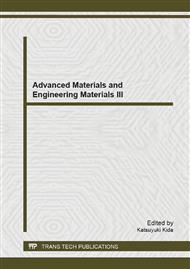[1]
M.M. Rahman, A. Elaissari, Multi-stimuli responsive magnetic core-shell particles: synthesis, characterization and specific RNA recognition, J. Colloid Sci. Biotechnol. 1 (2012) 3-15.
DOI: 10.1166/jcsb.2012.1006
Google Scholar
[2]
M. O. Avilés, A. D. Ebner, J. A. Ritter, In vitro study of magnetic particle seeding for implant-assisted-magnetic drug targeting: Seed and magnetic drug carrier particle capture. J. Magn. Magn. Mater. 321 (2009) 1586–1590.
DOI: 10.1016/j.jmmm.2009.02.091
Google Scholar
[3]
M. Lansalot, M. Sabor, A. Elaissari, C. Pichot, Elaboration of fluorescent and highly magnetic submicronic polymer particles via a stepwise heterocoagulation process. Colloid Polym. Sci. 283 (2005) 1267-1277.
DOI: 10.1007/s00396-005-1334-1
Google Scholar
[4]
L. Charoenmark, D. Polpanich, R. Thiramanas, P. Tangboriboonrat, Preparation of superparamagnetic polystyrene-based nanoparticles functionalised by acrylic acid, Macromol. Res. 20 (2012) 590-596.
DOI: 10.1007/s13233-012-0081-7
Google Scholar
[5]
C. Kaewsaneha, P. Opaprakasit, D. Polpanich, S. Smanmoo, P. Tangboriboonrat, Immobilization of fluorescein isothiocyanate on magnetic polymericnanoparticle using chitosan as spacer, J. Colloid Interf. Sci. 377 (2012) 145-152.
DOI: 10.1016/j.jcis.2012.03.008
Google Scholar
[6]
K. Chen, Y. Zhu, Y. Zhang, L. Li, Y. Lu, X. Guo, Synthesis of magnetic spherical polyelectrolyte brushes, Macromolecules, 44 (2011) 632-639.
DOI: 10.1021/ma102337c
Google Scholar
[7]
C. Kaewsaneha, P. Tangboriboonrat, D. Polpanich, M. Eissa, A. Elaissari, Anisotropic Janus magnetic polymeric nanoparticles prepared via miniemulsion polymerization, J. Polym. Sci. Part A. 51 (2013) 4779–4785.
DOI: 10.1002/pola.26902
Google Scholar
[8]
V. Holzapfel, M. Lorenz, C.K. Weiss, H. Schrezenmeier, K. Landfester, V. Mailänder, Synthesis and biomedical applications of functionalized fluorescent and magnetic dual reporter nanoparticles as obtained in the miniemulsion process J. Phys.: Condens. Matter 18 (2006).
DOI: 10.1088/0953-8984/18/38/s04
Google Scholar
[9]
H. Xie, S. Zhang, S. Li, Chitin and chitosan dissolved in ionic liquids as reversible sorbents of CO2, Green Chem. 8 (2006) 630–633.
DOI: 10.1039/b517297g
Google Scholar
[10]
J. Casanovas, D. Jacquemin, E.A. Perpète, C. Alemán, Fluorescein isothiocyanate: Molecular characterization by theoretical calculations, Chem. Phys. 354 (2008) 155-161.
DOI: 10.1016/j.chemphys.2008.10.008
Google Scholar
[11]
K. Landfester, L.P. Ramirez, Encapsulated magnetite particles for biomedical application, J. Phys. Condens. Matter 15 (2003) S1345–S1361.
DOI: 10.1088/0953-8984/15/15/304
Google Scholar
[12]
C. Kaewsaneha, P. Tangboriboonrat, D. Polpanich, M. Eissa, A. Elaissari, Facile method for preparation of anisotropic submicron magnetic Janus particles using miniemulsion, J. Colloid Interf. Sci. 409 (2013) 66–71.
DOI: 10.1016/j.jcis.2013.07.067
Google Scholar
[13]
Y. -D. Luo, C. -A. Dai, W. -Y. Chiu, Polystyrene/Fe3O4 composite latex via miniemulsion polymerization-nucleation mechanism and morphology. J. Polym. Sci. Part A. 46 (2008) 1014-1024.
DOI: 10.1002/pola.22444
Google Scholar
[14]
A. Elaissari, Magnetic latex particles in nanobiotechnologies for biomedical diagnostic applications: State of the art, Macromol. Symp. 281 (2009) 14-19.
DOI: 10.1002/masy.200950702
Google Scholar
[15]
N. Chekina, D. Horák, P. Jendelová, M. Trchová, M.J. Beneš, M. Hruby´, V. Herynek, K. Turnovcová, E. Syková, Fluorescent magnetic nanoparticles for biomedical applications, J. Mater. Chem. 21 (2011) 7630-7639.
DOI: 10.1039/c1jm10621j
Google Scholar


